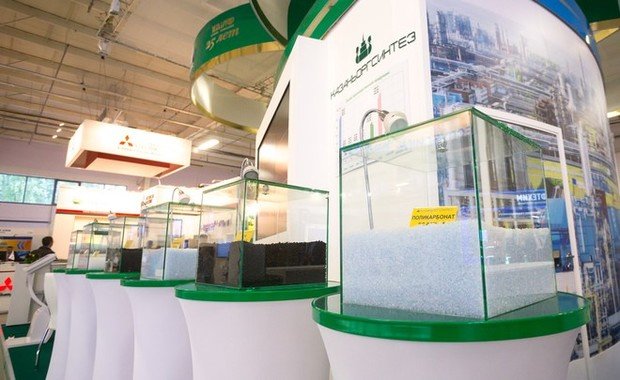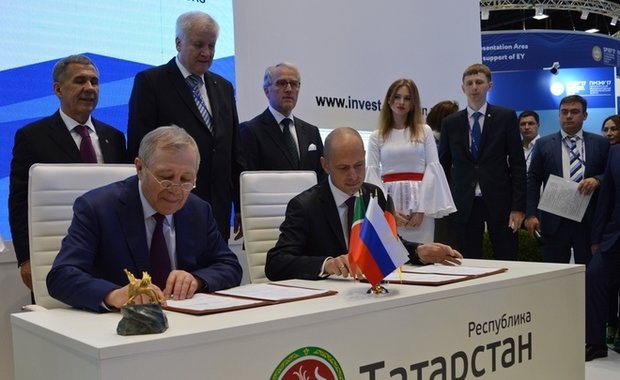Kazanorgsintez by Russian Accounting Standards in 2018: growth in net profit and revenue
Kazanorgsintez increased net profit by 30%
Last year, Kazanorgsintez PJSC's net profit totalled 19,9 billion rubles by Russian Accounting Standards, which is 30,6% more than in 2017. The enterprise's revenue also increased. Experts appreciated the development of Kazanorgsintez, which is a major budget revenue generating enterprise. They also made forecasts for the polymer market's development in 2019, told about the launch of new production capacities in Russia and a gradual rise in prices for plastics. Realnoe Vremya tells the details.
30% net profit growth
The petrochemical enterprise Kazanorgsintez PJSC has drawn conclusions for 2018 by RAS standards. The enterprise's net profit during this period totalled 19,9 billion rubles. It grew by 30,6% compared to 2017. Revenue in 2018 exceeded 79 billion rubles. This indicator is 9,7% higher than the 2017 result.

The rise in the indicators was provided by growth in sales of the main products of the enterprise. Sales profit rose by 4,3bn rubles and made up 24,4bn rubles. Moreover, sales prime cost grew by 2,6bn rubles only, to 47,9bn rubles.
The volume of the enterprise's non-current assets increased by 9,5bn rubles and exceeded 47bn rubles. At the same time, Kazanorgsintez PJSC has done without long-term borrowings for the second year in a row. It implements all new projects with its own money and profit.
Kazanorgsintez Annual General Meeting of Shareholders scheduled for 19 April
The next meeting of the Board of Directors chaired by Chairman of the Kazanorgsintez PJSC Board of Directors Ruslan Shigabutdinov took place at Kazanorgsintez PJSC in the middle of March. The annual report of the enterprise for 2018 was preliminarily confirmed, the annual accounting report was taken into consideration and recommended for approval at the annual General Shareholders' Meeting, which will be on 19 April.
The company's performance in 2018 was also considered and taken into consideration at the meeting, the annual Kazanorgsintez PJSC General Meeting of Shareholders was convoked, its agenda and data were chosen. The board of directors also recommended the General Meeting of Shareholders to distribute and pay out preferred share dividends of 0,25 rubles a share and 7,792 rubles a common share, having allocated 13,9bn rubles on dividend payout. Ruslan Shigabutdionv noted that the decision to pay out Kazanorgsintez share dividends exclusively falls within the competence of the General Meeting of Shareholders in accordance with the Federal Law On Joint-Stock Companies and the charter of Kazanorgsintez PJSC.
Experts about development of Kazanorgsintez
Evaluating the work of Kazanorgsintez PJSC in the fourth quarter of 2018, experts noted that the enterprise's capitalisation rose to 181,7bn rubles as of last year's 31 January, which is 26,51% more than at the end of the year. The enterprise's payroll fund increased by 4,2% compared to last year's analogous period, to 5,1bn rubles.
''We can note the company's good production results. So in the fourth quarter, it launched a new carbon black concentrate production plant, four pyrolysis furnaces in the ethylene factory were presented in the complex E-200. It's just part of the news of Kazanorgsintez, but even this news suggests that the enterprise successfully developed in the mentioned period, moreover, its development was integrated. The company had good news for investors, the staff and clients,'' said head of Finam-Kazan PLC Ruslan Zhukov.
''Polymer prices might gradually rise in the middle term''
Experts also assessed the development of the polymer market and noted a 6-7% fall in prices for plastics since last October. So according to the Russian Federal State Statistics Service, if ethylene polymers cost almost 89,000 rubles per tonne in October 2018, they fell to 83,000 rubles in December. Ethylene price, on the contrary, grew from 89,600 rubles in October to 91,000 in December. This January, according to the Russian statistics service, the prices continued falling a bit. Vasily Tanurkov, deputy director of the group of corporate ratings at ACRA, associated the price fall with oil price dynamics and the ruble rate.
Ruslan Zhukov cites several factors that could make an impact on the change of prices:
''First of all, the considerable growth of production volumes in the country could make an impact, which increased competition, and producers reduced prices to keep clients. A considerable amount of feedstock, moreover at a low price, had an influence, which allowed chemicals manufacturers to reduce their prices.
The price dynamics will depend on feedstock price, that's to say, how much hydrocarbons will cost in this period. The demand for products of the chemical sector in general is also important. Considering that more and more attention is paid to the disposal of different waste and different plastics, it's not excluded that this will make an impact on prices.

We can expect that demand for plastics, which decompose faster, can grow as well as prices for them while demand for traditional products can be lower, and prices for them might reduce. Both the regulation of the market, for instance, in fiscal policy, and different steps taken to tighten environmental protection legislation, complying with it can influence the market.
So the change in the VAT rate early this year will inevitably affect the price for chemical products, which can spur prices. On the other hand, high competition in the sector, plans of a number of companies to increase production capacities as well as new projects will affect the pricing. This might encourage companies not to raise prices too much to keep their market positions, to save the share. Imports will also have an impact because they won't stop completely, though their volume can reduce. This market will remain volatile in general. But given inflation, we shouldn't expect prices to reduce considerably, it's rather a gradual rise in the middle term.''
Petrochemical companies increase production volumes and set a course for abroad
Vasily Tanurkov notes significant growth of production volumes in some types of plastics in 2018. 5,7% more of polyvinyl chloride was made in Russia: the surplus was mainly exported. Ethylene production grew by 4,8%, benzene did by 3,3%. High-density polyethylene, low-density polyethylene, polypropylene production volumes grew, which helps reduce the difference between European and Russian polymer prices.
Ruslan Zhukov also noted the growth of polymer exports by calling it one of the causes of a sudden rise in production. A ''low base'' effect of the previous period and the import substitution could affect the production growth when consumers refused foreign products in favour of Russian. Experts note that Russian polymer producers ended 2018 in general quite well.
Vasily Tanurkov added that 2019 promises the polymer market that new factories will open.
''The launch of the chemical complex ZapSibNeftekhim is the most important event in the Russian market early in 2019. It plans to produce 500,000 tonnes of polypropylene and 1,5m tonnes of polyethylene a year. Its test launch was several weeks ago, while the complex will operate to the full during the year. The appearance of the new complex will create surplus polypropylene in Russia. 60% of commodities are supposed to go abroad,'' the expert said.

He also added that the size of the new complex in Nizhnekamskneftekhim whose construction will begin this year is comparable with ZapSibNeftekhim. Lukoil announced it would increase production capacities, too. Particularly it plans to increase polypropylene production to 500,000 tonnes and styrene to 300,000 tonnes in the Nizhny Novgorod refinery. Lukoil's investments in petrochemistry are partly linked with the growth of processing volumes. ''It's more profitable for the company to build a factory to process polypropylene than try to sell it as feedstock,'' Vasily Tanurkov explained.
He named the events that might make a negative impact on the Russian polymer market in 2019. So car sales in the world market reduced by 0,5% last year for the first time since 2009. Such a fall can adversely affect demand for rubber. Demand for plastics can also change due to the trade wars between China and the USA.
The expert notes that the plans to increase plastic production are so ambitious that the Russian market won't have space for it. Companies will increase sales outside Russia. Moreover, Russian producers abroad will be able to drive traditional players out. There might also be competition with new producers in Near East.